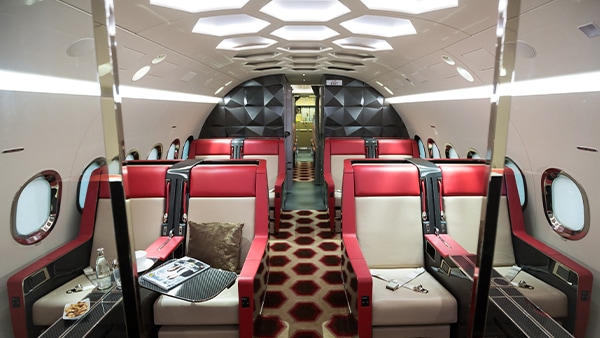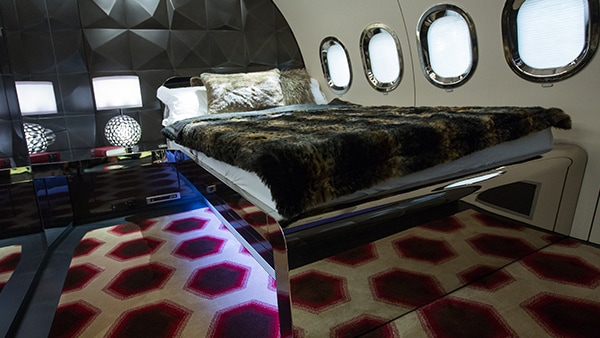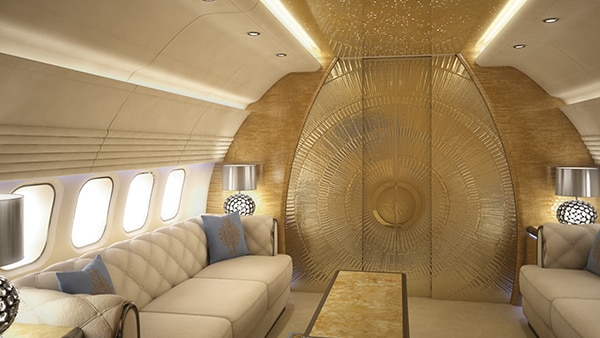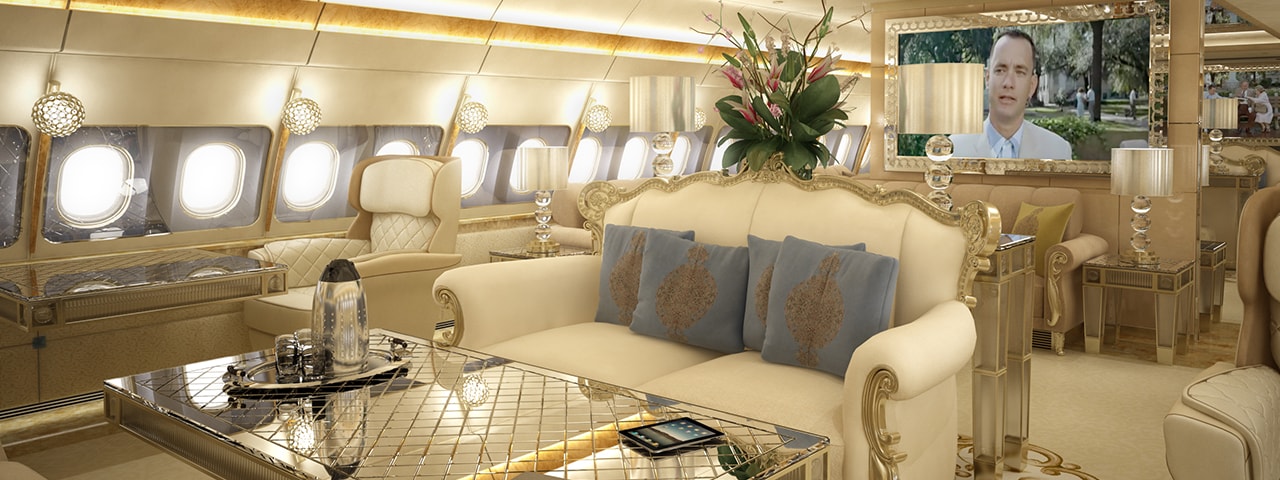The jet set
Johnny Davis deep dives into the world of private jet interiors
With private jet use on the rise, customised charter aircraft designed with luxury in mind are growing in popularity. They’ve come a long way – both literally and figuratively – because the earliest, rather utilitarian examples focussed on function above all else. Now, designers’ imaginations are running riot and a truly unique way to travel is within your reach.
First, a quick history lesson. The first private jet made available to the public in 1962 was the Lockheed Jetstar, which could travel at a cruising speed of 350mph and accommodate 11 passengers. The faster, more fuel-efficient Learjet 23 followed in 1964 and it became a favourite with celebrities for its speed and its convenience – Frank Sinatra was a notable early adopter. The cabin of his jet emphasised comfort, with two leather seats in the back and a divan for three or four extra passengers as needed, plus a fully stocked drinks cabinet and a card table.


The Gulfstream II followed and it signalled a significant upgrade, featuring leather upholstery, a private telephone, air conditioning and a sound system with an array of speakers positioned throughout the cabin. As an early sign of a private jet essential, it also featured an entertainment system with TVs and VHS players.
Inevitably, things got bigger by the mid-1970s. ‘The Starship’, a refitted Boeing 720, was made famous by Led Zeppelin and other touring celebrities including Elton John, John Lennon and the Rolling Stones. It featured a huge couch, swivel chairs, a 30ft bar and a private chef. The back of the plane was kitted out with a queen-size waterbed with a white fur bedspread that added another 1,500lb to the weight of the plane.
Reinventing the wing


Today, private jets are second homes in the air, with plenty sporting mod cons normally found in luxury residences and offices. Champagne bars, dining tables and gyms are just some concepts becoming a reality and personalisation is key because freedom of expression is the priority.
“Passengers lead busy lives and appreciate a certain calm and tranquillity,” says Richard Whitehouse, director at British-based aviation design company Harrison Eidsgaard. “It needs to feel special and the challenge in high-end interior design is to create something long-lasting and beautiful that is also spectacular and very personal.
“There have been huge leaps in technology that influence connectivity and the quality of onboard entertainment but, because we can work 24/7 from anywhere, we are also seeing that clients need places where they can fully switch off. Jets are typically designed to allow for both work and a break from work.”
Take the Dassault Falcon 10X, which is set to take to the air in 2025. The £59m aircraft is dubbed ‘the penthouse of the skies’ and features options for bookcases, convection ovens and a bathroom bigger than some boutique apartments. Or perhaps you might like the Embraer Lineage 100E, a £42m jet featuring five ‘interior zones’ and a queen-size bed. At the most extravagant end, Paris-based Alberto Pinto Interior Design has created an airborne walk-in shower for an Airbus ACJ319 – a rarity in private jets because of the weight of the water – as well as a fully functioning kitchen and a feng shui living space.
“Personalisation depends entirely on the owner; some want bedrooms and en suites in the back, others want them in the front, but a common theme is the demand for high-speed internet and state-of-the-art entertainment systems,” says New York-based designer Edése Doret, who has fitted out more than 30 jets for clientele and once received a brief from the Obamas to redesign Air Force One. “We have an initial client meeting where we present several layout options followed by photorealistic renderings of key areas before presenting the trim and finish options. After a cabin is installed, there are a series of test flights before re-delivery to the customer.”
Howard Guy, CEO of British consultancy Design Q, adds: “Our job is to surprise and delight; to do something they haven’t seen, and cannot see, anywhere else. It wasn’t that long ago that the interior of a typical business jet could never have been judged as ‘contemporary’ or offer any kind of ‘wow factor’.” When Guy and his team were asked to redesign the interior of the Bombardier Global 7500, the brief was to abandon the customary grey military-style design and treat the cabin like a luxury car, with a focus on premium materials. “They wanted the same high quality as a Rolls-Royce, and that’s what we gave them.”
En vogue interiors


Despite the occasional unorthodox request, today’s private jet interior business is typically more refined and less ostentatious than the Led Zeppelin days. Current trends include a vogue for a ‘soft modern’ style characterised by wood and leather, more fluid shapes and modern materials such as carbon fibre, vegan leather and recyclable fabrics.
"We have noticed an increase in requests for interior design in aircraft of a larger scale, especially for luxury charter and business jet companies which want to redefine corporate jet standards,” says Yves Pickardt, aircraft interior specialist at Alberto Pinto Interior Design. “Whatever their style, new materials such as carbon fibre, cold metallisation, vegan, ecological and recyclable fabrics and leather are increasingly making their way into aircraft.”
The designer’s challenge, then, is to create something long-lasting and beautiful but also unique and personal. Unlike a yacht, where weight isn’t as critical, jet interiors require both artistic and technical expertise because of regulations governing safety, flammability of materials and so on.
This emphasises unique touches, as embodied by London-based designer Colin Radcliffe, who oversaw the revamp of an Airbus ACJ319neo in the style of a 1930s Art Deco ocean liner complete with embroidered wallpaper and handmade antique mirrors. Or perhaps you might appreciate the BBJ Max 7 designed by Canada’s Camber Aviation and inspired by the Rolls-Royce Boat Tail cabriolet. Designed with flexibility for passengers in mind, it features stow away dining tables and a retractable Champagne bar revealing a hidden video screen.
Despite some aircraft now offering actual bedrooms, sleep isn’t necessarily the priority we might think. “For four-hour flights, you can really open out the space [where you’d put a bed],” says Guy. “People don’t always want seats that look like old-fashioned captain’s chairs; they want loveseats, so you can walk around them. That opens up loads of possibilities.
“We’ve done a Global 8000 with a full sky-blue ceiling and clouds in 3D,” he adds. “Because of the controllable strobe lighting, it looks like the clouds are moving. We’ve combined that with a concept where it’s a regular sky with clouds in the daytime but at night-time, when the lights go down, stars come out.” One wonders what Frank Sinatra would make of it all – after all, surely there was only room for one star on his private jet.
Picture Credit: Edése Doret Industrial Design & Design Q

 Johnny Davis deep dives into the world of private jet interiors.
Johnny Davis deep dives into the world of private jet interiors.

